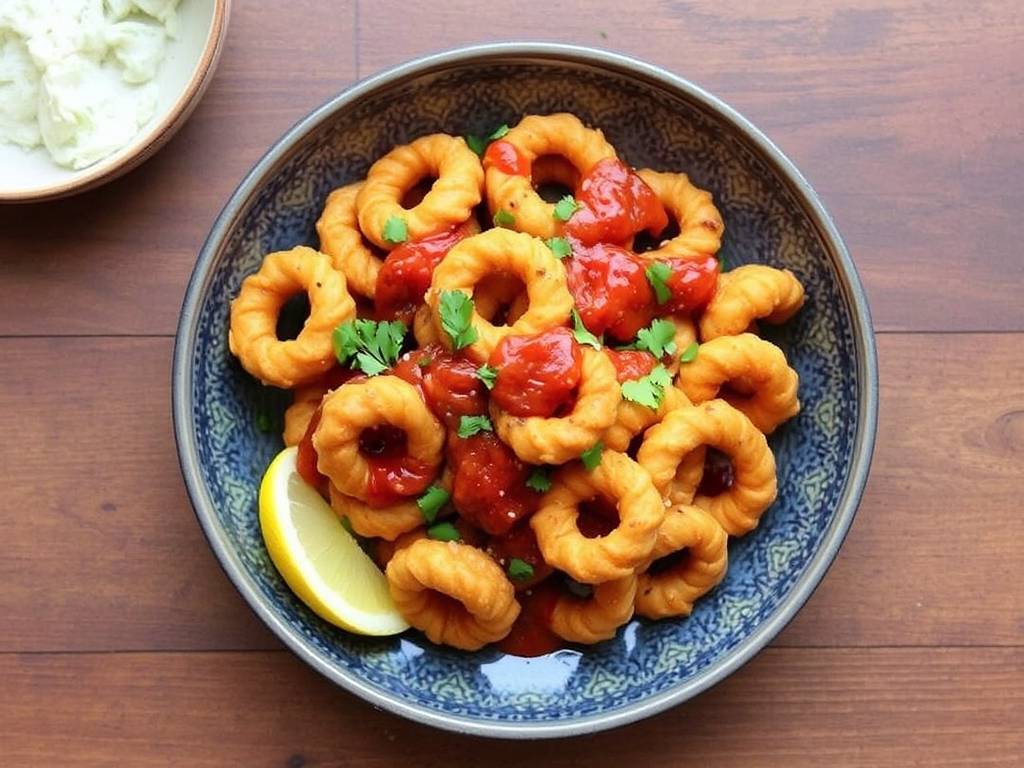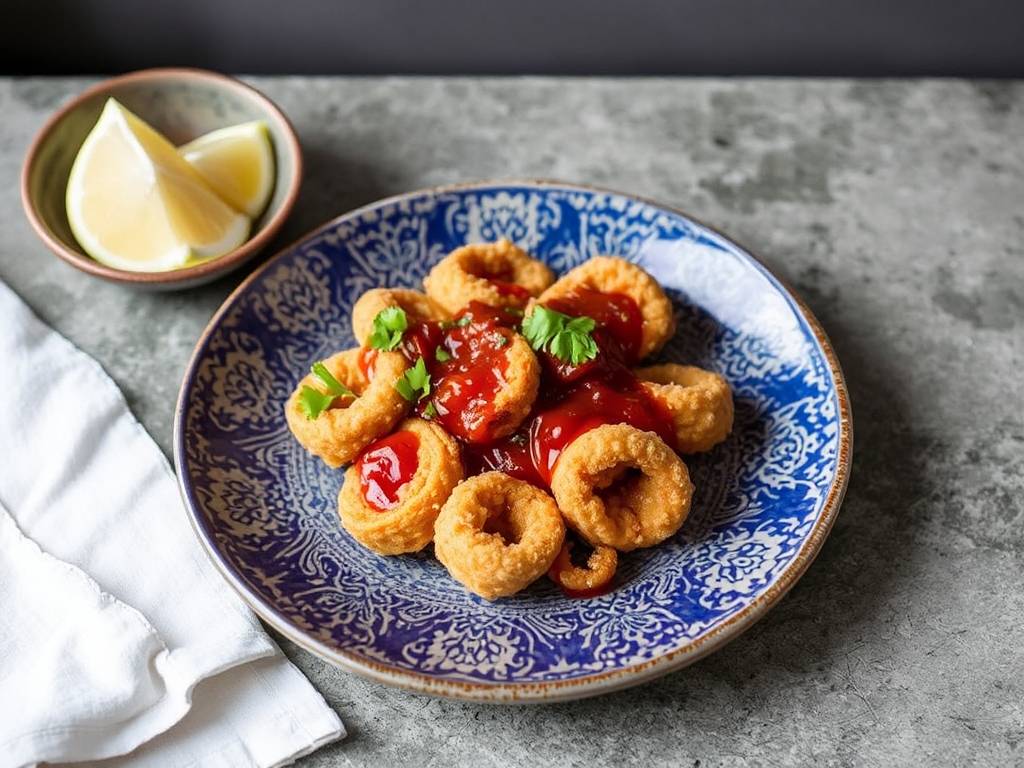The Ultimate Guide to Perfectly Crispy Fried Calamari with Homemade Marinara
There's something universally delightful about a plate of golden, crispy fried calamari. That satisfying crunch giving way to tender, flavorful squid, all complemented by a tangy, herbaceous marinara sauce. It’s a classic appetizer that feels both celebratory and comforting. Yet, for many home cooks, achieving that professional-level crispiness without ending up with rubbery squid can seem like a daunting task.
Fear not! This comprehensive guide is designed to walk you through every single step, demystifying the process and empowering you to create a restaurant-quality fried calamari dish right in your own kitchen. We'll cover everything from selecting the right squid to crafting a from-scratch marinara sauce that will elevate your meal. Let's dive into the secrets of making the best crispy fried calamari.

Selecting and Preparing Your Squid
The journey to perfect calamari starts with the main ingredient. You'll typically find squid sold as either whole tubes and tentacles or pre-cut rings. For the freshest flavor and best texture, I recommend purchasing whole, cleaned squid.
- Fresh vs. Frozen Squid: Don't shy away from high-quality frozen squid. It's often flash-frozen shortly after being caught, which locks in freshness. Just ensure it's thoroughly thawed in the refrigerator before use.
- The Right Cut: Calamari rings are classic, but don't forget the tentacles! They offer a wonderful texture and are considered a delicacy by many. Slice the squid tubes into 1/2-inch to 3/4-inch rings. If they are too thin, they can overcook quickly; too thick, and they might not cook evenly.
- The Tenderness Secret: Many believe squid is either tender or rubbery, with no in-between. The key is cooking time. Squid needs either a very brief cook (1-2 minutes) for tenderness or a long, slow braise (30-45 minutes) to break down its fibers. For frying, we're firmly in the "brief cook" camp.
A crucial, often-overlooked step for ensuring tender calamari is to pat it completely dry. Use several layers of paper towels to soak up every bit of moisture on both the rings and tentacles. This is the first and most critical step toward achieving a crispy coating, as moisture is the enemy of crispiness.
Creating the Perfect Crispy Coating
The coating is what transforms soft squid into a textural masterpiece. The goal is a light, shatteringly crisp shell that doesn't fall off. We'll explore a simple, highly effective double-dredging technique.

- The Dry Base Layer: Start by tossing your thoroughly dried calamari in a mixture of all-purpose flour, cornstarch, salt, and black pepper. A ratio of about 3 parts flour to 1 part cornstarch works wonders. The cornstarch is a game-changer for crispiness, as it fries up lighter and crispier than flour alone. This initial dry layer helps the subsequent wet batter adhere properly.
- The Wet Batter for Ultimate Crispiness: For the wet layer, we'll use a simple but effective batter. Whisk together 1 cup of all-purpose flour, 1/2 cup of cornstarch, 1 teaspoon of baking powder (this adds air and extra crunch), and a teaspoon of salt with about 1 to 1.5 cups of very cold club soda or sparkling water. The carbonation creates a lighter, airier, and incredibly crisp crust. The batter should be the consistency of thin pancake batter—it should coat the squid but not be gloppy.
- Double-Dredge for Durability: Take your flour-dusted calamari pieces, shake off the excess dry flour, and then dip them into the cold batter, letting any excess drip back into the bowl. This two-step process creates a sturdy, cohesive coating that will stay firmly attached to the squid during the vigorous frying process.
Mastering the Frying Process
The final hurdle is the fry. Proper temperature and technique are non-negotiable here.
- Choosing Your Oil: Use an oil with a high smoke point, such as vegetable, canola, or peanut oil. You'll need enough to fill your heavy-bottomed pot or Dutch oven by about 2-3 inches.
- The Critical Temperature: Heat your oil to 375°F (190°C). Use a deep-fry or candy thermometer for accuracy. If the oil is too cool, the calamari will absorb oil and become greasy. If it's too hot, the coating will burn before the squid inside cooks.
- Fry in Batches: Do not overcrowd the pot. Adding too much calamari at once will cause the oil temperature to plummet. Fry in small batches for just 2-3 minutes, until they are a beautiful, pale golden brown. They will not darken significantly until they are out of the oil.
- Drain Properly: As soon as you remove the calamari from the oil, place them on a wire rack set over a baking sheet. This allows air to circulate all around them, keeping them crispy. Avoid using paper towels alone, as they can trap steam and make the bottom soggy. Season immediately with a little flaky sea salt while they are still hot.
Crafting a Simple, Flavorful Homemade Marinara Sauce
While your calamari is delicious on its own, a vibrant homemade marinara sauce is the perfect partner. This simple recipe comes together while your oil is heating.
- Sauté Aromatics: In a saucepan, heat a couple of tablespoons of olive oil over medium heat. Add 2-3 minced garlic cloves and a pinch of red pepper flakes, sautéing for just 30 seconds until fragrant.
- Build the Sauce Base: Add one 28-ounce can of high-quality crushed tomatoes (San Marzano are excellent for their sweet, low-acidity flavor). Stir in a teaspoon of dried oregano, a few fresh basil leaves (or a teaspoon of dried), and a pinch of sugar to balance the acidity.
- Simmer to Perfection: Bring the sauce to a gentle simmer, then reduce the heat to low. Let it cook for 15-20 minutes, allowing the flavors to meld. Season with salt and pepper to taste. For a smoother sauce, you can use an immersion blender, but a rustic texture is wonderful here.
Serving and Enjoying Your Masterpiece
Bring your crispy fried calamari and warm marinara sauce to the table immediately. Garnish the calamari with a squeeze of fresh lemon juice and some chopped fresh parsley. The bright acidity of the lemon cuts through the richness of the fried food beautifully.
This guide has taken you through the entire process, from selecting the best squid to mastering the double-dredge technique and frying at the perfect temperature. You now possess all the knowledge to confidently create an unforgettable plate of crispy fried calamari with homemade marinara sauce that will impress your family and friends. Happy cooking






发表评论